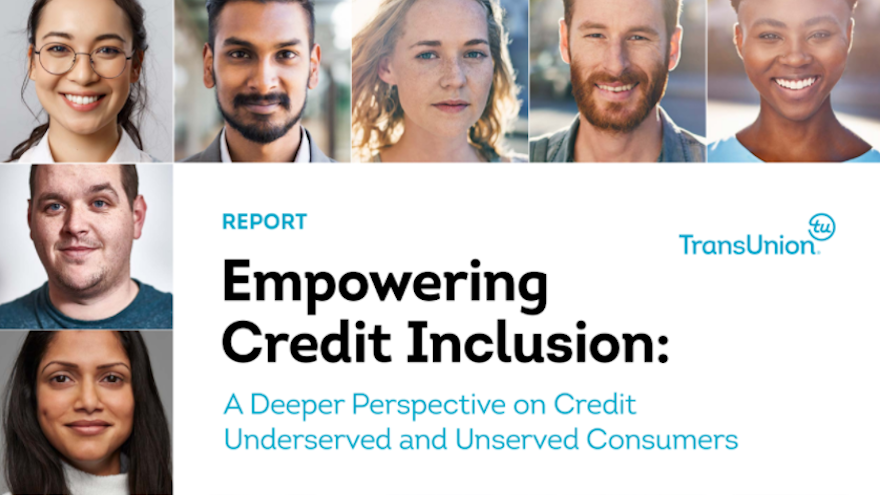TransUnion study spots trends involving more than 45M Americans who are either credit unserved or underserved

Screenshot courtesy of TransUnion.
The newest global study by TransUnion showed how much credit is being utilized, especially by individuals classified as either credit unserved or underserved.
TransUnion reported on Thursday that more than 45 million consumers are considered to be either credit unserved or underserved in the United States.
However, TransUnion’s study determined that about one in four consumers — 24% to be exact — who started as credit underserved were found to have migrated to becoming credit active in a two-year window prior to the pandemic.
During the height of the pandemic, TransUnion also noticed that the percentage of consumers becoming more credit active decreased slightly to 22%, with the profile of those consumers skewing younger than the pre-pandemic sample.
In addition to the United States, the TransUnion global study titled, “Empowering Credit Inclusion: A Deeper Perspective on Credit Underserved and Unserved Consumers,” observed consumer credit behavior in Canada, Colombia, Hong Kong, India and South Africa. TransUnion said in a news release that the company compiled the study to get a better sense of the market size of these unserved and underserved consumer segments.
“Our study clearly points to hundreds of millions of consumers around the globe being credit unserved or underserved,” said Charlie Wise, senior vice president and global head of research and consulting at TransUnion. “These credit disadvantaged consumers are often unable to access financial products and services because they have no, or little, credit history.
“This study served to better understand how many people are truly under- or unserved from a credit perspective, while also determining paths for them to gain more credit opportunities,” Wise continued in the news release.
TransUnion explained the study explored the characteristics and behaviors of credit unserved and underserved consumers and their overall sentiments toward credit, while offering key insights into the credit journeys of these consumers.
Analysts pointed out that unserved consumers are defined as any person who has never had an open traditional credit product (such as a credit card, personal loan, or auto financing, to name a few) as reported on the TransUnion consumer credit database.
TransUnion also noted the underserved population has minimal credit participation, limited to a single type of credit product and no more than two open accounts of that type, and have been active in the credit market for at least two years.
This study specifically excluded new-to-credit consumers — those who have opened their first product within the past two years — from the underserved population, as many of those new-to-credit consumers become more fully credit active soon after opening their first product.
According to TransUnion, the study sought to understand those consumers who remain unserved or underserved over a longer time period.
Analysts said two cohorts of consumers were studied, each over a two-year time period. The first was during the pre-pandemic period beginning March 2018 through March 2020, and the second beginning in June 2019 and studied through the pandemic time period of June 2021.
TransUnion wanted to determine if there were any pandemic-related shifts with consumer credit migration trends.
While some unserved consumers (also called credit inactive consumers) may have traditional credit scores when they open their first credit product, analysts noted that many consumers do not.
Wise explained this lack of a credit score and any history of credit activity is an impediment for these unserved consumers to get their first credit product, as many finance companies are hesitant to extend credit to consumers without any credit history or score.
For these traditionally unscorable consumers, Wise said they face a “chicken or egg” conundrum of how to get that first credit product when they lack a credit history.
“This reality underscores the importance of incorporating alternative data into the financial ecosystem so that fewer consumers find themselves as credit invisible. Once these consumers can be evaluated by financial institutions, lenders can better determine where there might be new opportunities for growth and how they can expand credit inclusion,” Wise said.
The study also found that consumers who migrated from underserved to served (opened at least one new product type) over the two-year period had more inquiries — applications for new credit — than consumers who remained underserved.
While some of that higher inquiry activity was attributable to the fact that they opened new accounts, TransUnion indicated the overall higher level of inquiry activity by those consumers who migrated to the served segment implies that these consumers have a significantly higher demand for new credit, and that this demand is not necessarily being met by lenders and finance companies.
“The number of new credit inquiries were materially higher for consumers that migrated to served compared to consumers who remained underserved,” Wise said. “These consumers appear to want more credit, but they are not necessarily able to access the credit they want, potentially due to their limited credit history. This highlights a missed opportunity for lenders who are seeking to grow and add new customers.
“Many of these underserved consumers would likely be well-performing and profitable borrowers, but because of their limited credit history, lenders are reluctant to extend them credit,” Wise added. “Incorporating alternative data on consumers into lending decisions could enable lenders to get a fuller picture of the financial capacity of underserved consumers and make credit available to more of them.”
To learn more, TransUnion is offering a webinar titled, “Addressing Credit Needs of Underserved Consumers.”
For more information and insights from the global TransUnion study, “Empowering Credit Inclusion: A Deeper Perspective on Credit Underserved and Unserved Consumers,” you can download the report via this website.


